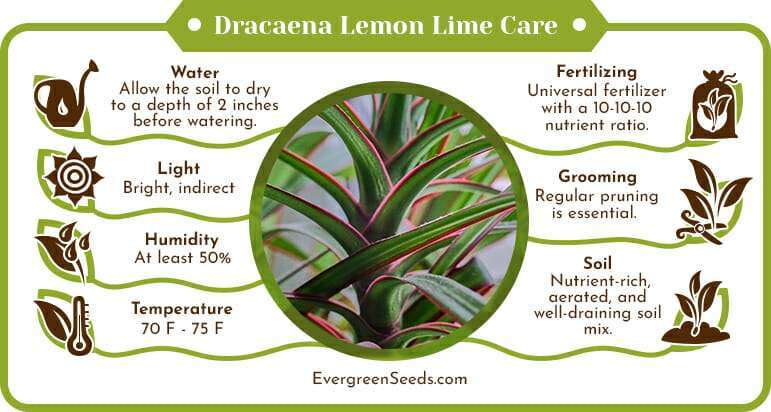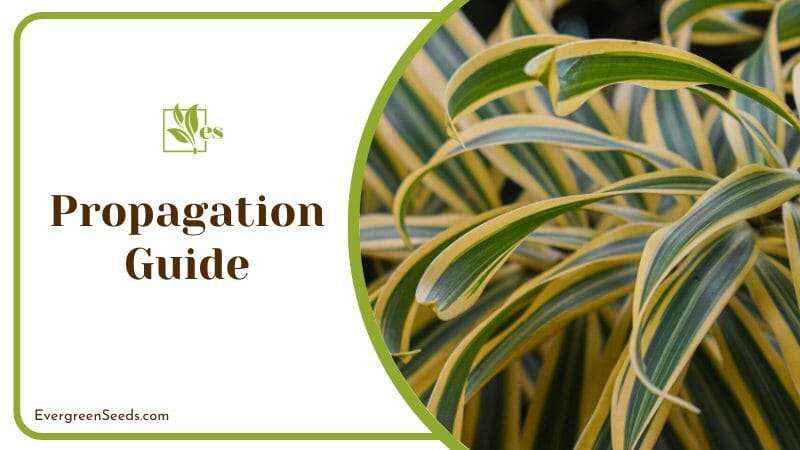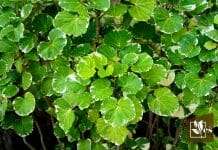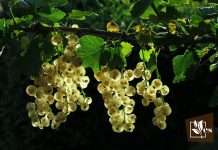
Dracaena lemon lime care is surprisingly easy, making it a perfect beginner plant for anyone!
Boasting a visually stunning display, Dracaena lemon lime is one of the best houseplants within the Dracaena genus for beginners and pros alike who are looking for a splash of vivid color.
A slow grower, it’ll keep you busy for years. In this grow guide, our experts reveal their top tricks and tips for the Dracaena fragrant species to keep your Dracaena lemon lime thriving for many years!
JUMP TO TOPIC
Dracaena Lemon Lime Care Guide
 Light Requirements
Light Requirements
We recommend growing your Dracaena lemon lime in bright indirect light. Dracaena plants can tolerate a wide range of light conditions, but although they can be kept in partial shade, they will grow very slowly. To keep the vibrant foliage of your lemon lime plant, bright filtered sunlight is ideal. Avoid exposure to full sun, as this will cause leaf discoloration and burn marks.
When growing Dracaena lemon lime indoors, the best spot is a room that’s facing east or west. You can keep the plant close to the window, but only in the morning when the sun is not intense enough to damage the foliage.

Otherwise, you can use a sheer curtain to filter out the sun and keep the leaves healthy. North-facing rooms are too dark for this plant, as they can cause leggy growth.
 Temperature Requirements
Temperature Requirements
The ideal temperature range for Dracaena lemon lime is between 70 and 75 F (21 to 24 C). This may seem like a rather narrow range, but luckily, it’s the average temperature in most homes. If you want to grow Dracaena outdoors, you can do so in USDA zones 9 to 11. A part of your garden that’s sheltered from the wind and the intense midday sun would be perfect.
Dracaena lemon lime is deathly sensitive to cold. All Dracaena plants have a low tolerance to temperatures below 60 F (15 C). If temperatures drop even lower, this can result in permanent root damage, and saving your Dracaena from cold damage may be impossible.
If you plan on growing Dracaena lemon lime outdoors, make sure that nighttime temperatures in your area never drop below 55 F (13 C). A good tip is to keep the plant in a pot and bring it back indoors when it gets too cold.
 Water Requirements
Water Requirements
Dracaena lemon lime has moderate watering needs. It will be forgiving if you forget to water it for a day or two but can suffer greatly if it’s overwatered. Our recommendation is to allow the soil to dry to a depth of 2 inches (5 cm), then give the plant a good soak. Make sure that the plant is never sitting in water, and that the container has adequate drainage holes at the bottom.
Dracaena plants are very sensitive to the harsh chemicals in tap water, especially chlorine, sodium, and fluoride. If you notice that the leaves are developing brown, dried tips with yellowing edges, that’s a classic sign that your tap water is too hard. To prevent these brown tips, always use filtered, distilled, or rainwater for your Dracaena lemon lime.
 Humidity Requirements
Humidity Requirements
Dracaena lemon lime can tolerate the average home humidity but will truly shine if you can boost it to at least 50 percent. As a rule of thumb, all Dracaena plants with wide leaves will need more humidity than those with narrow leaves, such as Dracaena colorama. This is because the wider leaf surface causes the plant to lose more moisture through transpiration.
You don’t need to do anything too fancy to meet Dracaena lemon lime’s humidity needs. Placing the container on top of a pebble tray half filled with water will do the job nicely. There’s no need to mist the plant or go all-out on buying a humidifier.
 Soil Requirements
Soil Requirements
Plant your Dracaena lemon lime in a soil mix that is nutrient-rich, aerated, and well-draining. This plant is not pretentious when it comes to soil, and you can meet its requirements by combining two parts universal potting mix with one part perlite or pumice.

Good drainage is the most important factor in keeping your lemon lime Dracaena healthy. Thick, heavy soils stay wet for too long, prevent oxygen from reaching the roots, and make it difficult for the plant to absorb the nutrients it needs.
Most overwatering problems are actually caused by poor drainage, not by the amount of water you give your plant. As a result, always make sure that at least one-third of your potting mix consists of amendments that improve drainage.
 Fertilizer Requirements
Fertilizer Requirements
Dracaena lemon lime can benefit from a light fertilizer application throughout its growing season. Once a month, from mid-spring until early autumn, give the plant a universal fertilizer, diluted to half the strength. A nutrient ratio of 10-10-10 is perfect.
Never apply fertilizers if the soil of your Dracaena lemon lime is more than 50 percent dry, as this can result in fertilizer burn. This plant can also suffer from fertilizer salts building up in the soil, so remember to flush them out once every two or three months. To do that, slowly pour water through the soil for about 10 minutes, then allow the pot to drain in a sink or bathtub for a few minutes.
 Pruning and Maintenance
Pruning and Maintenance
Dracaena lemon lime can grow up to 7 feet (2.1 meters) tall and can produce long, bare stems. Regular pruning is essential if you want to keep this plant contained and give it a bushy look.
On average, you can start pruning the plant when the stem is at least one foot (30 cm) tall. The best time to prune this plant is in spring, which allows it to use the rest of the growing season to produce new growth.
To prune your lemon lime Dracaena, start by sterilizing your blade with rubbing alcohol. You can cut the tips of the green stems, making the cut between two leaves. Or, if your Dracaena needs a more serious trim, you can cut off the entire top of the plant. The bare stem will produce buds that will grow into lateral stems, giving the plant a fuller look.
If you prune your Dracaena until it’s left with nothing but the main, bare stem, remember to cut down on watering. Given the fact that the plant doesn’t have leaves, it will need less water until the buds emerge. Also, remember to keep your stem cuttings for propagation.
Repotting
Dracaena lemon lime has a slow growth rate and only needs to be repotted once every two to three years. We recommend doing this in spring if you see that the roots are starting to come out through the drainage holes. Remove the plant from its old container, and move it to a pot that’s one size larger.
The best material for Dracaena lemon lime pots is ceramic or terracotta. This plant can become very top-heavy after a few years, and the weight of the pot should prevent it from falling over. Unglazed clay pots also help wick out excess moisture from the soil, and their porous nature improves air circulation to the roots.
Propagation Guide
You can propagate your Dracaena lemon lime using stem cuttings. This method works best in spring when you can use the stems removed during pruning to make new plants.

Here is our step-by-step guide for propagating the lemon lime plant.
- Use a sharp, sterilized blade to cut the stem.
- If you’re cutting the young, green stems, make the cut between two leaves, then remove some of the lower leaves until you have a stem section about 2 inches (5 cm) long. The resulting cutting should have at least three or four leaves attached.
- If you’re cutting the top of the plant, cut the stem 2 inches (5 cm) below the lowest leaves.
- Wait for a couple of days for the bottom of the cutting to develop a callus. In the meantime, keep the cutting in a dry, well-ventilated room, away from direct sun.
- You can propagate your Dracaena cuttings in water or directly in the soil. If you want, you can apply some rooting hormone, although the cuttings will develop roots without it as well.
- The cuttings should develop roots after a couple of weeks. If you’re propagating in water, wait until the roots are at least 3 inches (7.6 cm) long before planting the cutting in a well-draining soil mix.
Common Pests and Problems
The lemon lime Dracaena doesn’t typically suffer from pests and diseases. However, it can be susceptible to root rot, and can also suffer if the tap water in your home is too hard. Here’s what you will need to keep an eye out for.
– Brown Leaf Tips
This indicates that the tap water in your home is too hard, and the leaves are damaged by fluoride and chlorine. We recommend watering your Dracaena lemon lime with either distilled, filtered, or rainwater instead.
– Yellowing Leaves
It’s normal for the older leaves of your Dracaena to turn yellow and fall off. This is how the plant grows and develops its bare stem. However, if newer leaves are turning yellow, that’s a sign of overwatering and possibly root rot. Repot your plant in a well-draining soil mix, and avoid overwatering it in the future.
– Brown Leaf Spots
Your Dracaena is either overwatered or underwatered. Keep a consistent watering schedule, and give the plant a good soak when the top two inches of the soil feel dry to the touch.
– Pests
Spider mites, mealybugs, and scale can, on rare occasions, trouble your Dracaena lemon lime. To get rid of them, spray the leaves with a solution of water and isopropyl alcohol. Repeat the treatment once a week, for a month.












